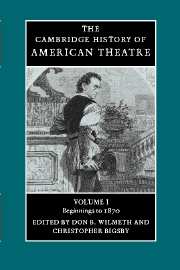Book contents
- Frontmatter
- Introduction
- Timeline: beginnings to 1870
- 1 American theatre in context, from the beginnings to 1870
- 2 Structure and management in the American theatre from the beginning to 1870
- 3 Plays and playwrights
- 4 The Actors
- 5 Scenography, stagecraft, and architecture in the American theatre: beginnings to 1870
- 6 Paratheatricals and popular stage entertainment
- Bibliography
5 - Scenography, stagecraft, and architecture in the American theatre: beginnings to 1870
Published online by Cambridge University Press: 28 March 2008
- Frontmatter
- Introduction
- Timeline: beginnings to 1870
- 1 American theatre in context, from the beginnings to 1870
- 2 Structure and management in the American theatre from the beginning to 1870
- 3 Plays and playwrights
- 4 The Actors
- 5 Scenography, stagecraft, and architecture in the American theatre: beginnings to 1870
- 6 Paratheatricals and popular stage entertainment
- Bibliography
Summary
The colonial period
Until the arrival, in 1749, of identifiable actors and managers in the eastern part of the American continent, the nature and practice of theatrical performance are matters almost entirely of historical conjecture. What records exist of theatrical activity make little or no mention of playhouses, scenery, or modes of performance. We know from at least one instance in the sparse chronicles of colonial theatre that, in 1665, three young men, who were accused of “acting a play of ye Bare and ye Cubb, on ye 27th of August” (quoted in Odell, 1, 4), were ordered to appear in court in “those habilments that they acted in” before the judge in Accomac County, Virginia. Whether it was the costumes they wore or the excerpts from the play they recited for the judge’s edification, we know that he was persuaded to find them not guilty.
If the young men at the College of William and Mary in Williamsburg, Virginia, indulged in theatrical activities (as some believe), they left little evidence of their efforts, but a few historians have read into these intimations a sense that the Virginia colony, and the South in general, was somewhat more tolerant of theatrical practice than its northern counterparts. Their position is strengthened by the discovery of the foundations of a playhouse, built sometime between 1716 and 1718, in Williamsburg. Erected by William Levingston, a merchant of New Kent County, the playhouse was probably nothing more than a large barn built with wood posts and beams with joists carrying the weight of the floor and ceiling.
- Type
- Chapter
- Information
- The Cambridge History of American Theatre , pp. 373 - 423Publisher: Cambridge University PressPrint publication year: 1998
- 1
- Cited by



